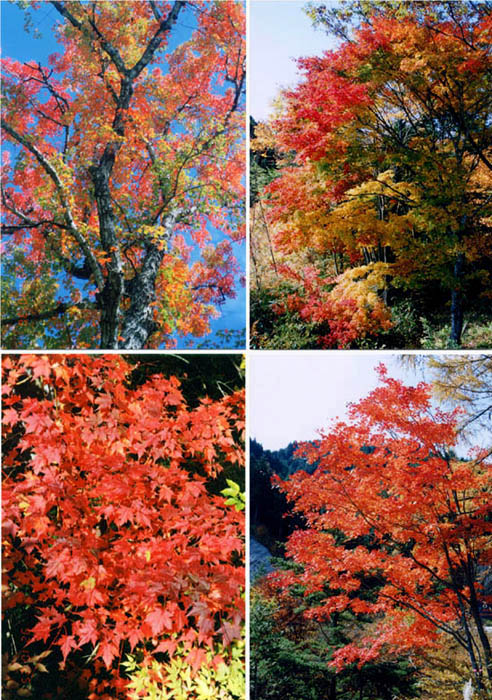
Autumn colours in Wales in 2014 : offered by Mr. Graham Berry
Let me show you Autumn colors in Japan.
Landscape of four seasons of Hakuba village in 2009-2012
Scenery of four seasons of Sanzen-in Temple in 2011-2012
Autumn colors in Heirinji Temple in Saitama Pref. on Dec.09, 2011
Autumn colors in Johjakkohji Temple, Kyoto on Nov.26, 2011
Autumn colors in Tenryuji Temple, Kyoto on Nov.26, 2011
Autumn colors in Hohgon-in Temple, Kyoto on Nov.26, 2011
Autumn scenery of Chausu-yama Highlands on Oct. 20, 2011
Scenery of four seasons of Ikkyuji Temple in 2008-2011
Autumn colored scenery in Kohrankei in 2010
Autumn colors in 2006
Autumn colors in 2005
----------
Autumn colors at The Chausuyama Highlands on 6. Nov. '99
Autumn colors at The Shirabiso Highlands on 30. Oct. '99
Autumn colors at Hohhei-Ravine in Hokkaido on 23. Oct. '99

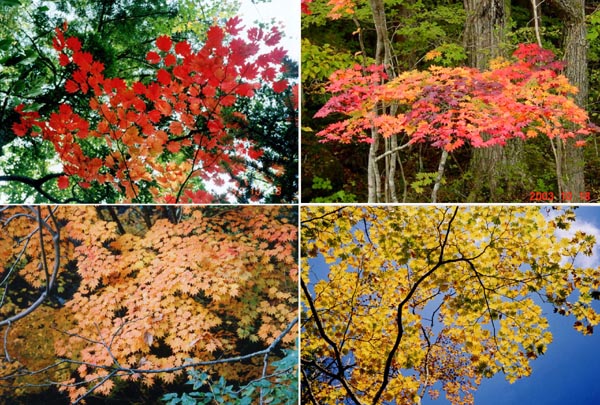
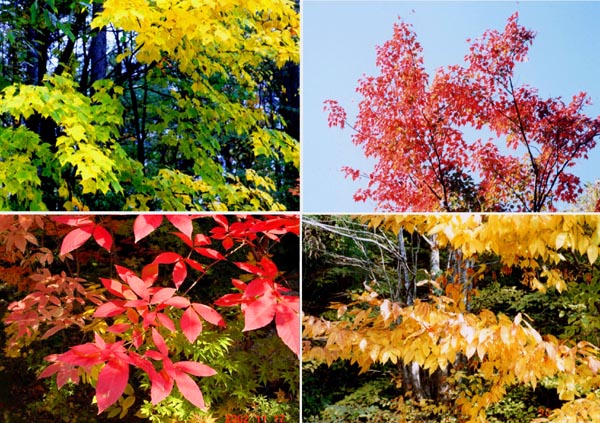
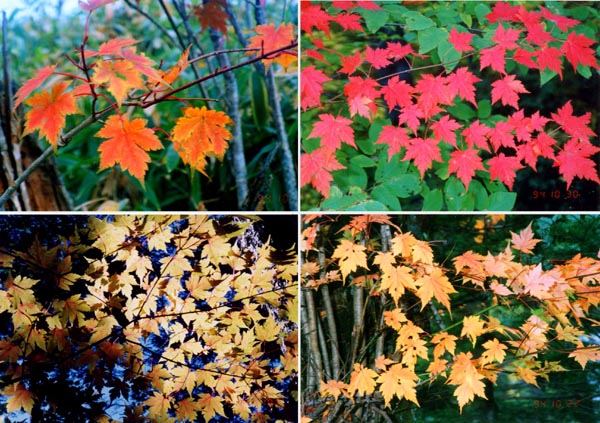
the Shirabiso pass, Nagano |
Mt. Chausu, Aichi side |
Mt. Mizugaki, Yamanashi |
Komagane, Nagano |
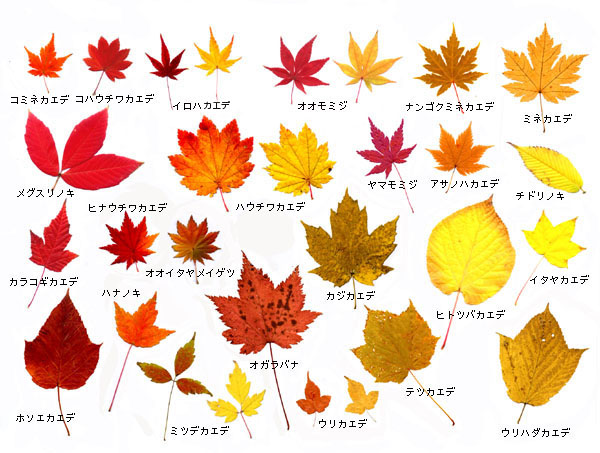
A. Maple viewing news etc.
Let me introduce a HP which carries all sights of autumn color in Kyoto.
"Momiji Guide" by Kyoto Tourism FederationB. Noted places of Maple viewing in Japan
...... quoted from "Hana no Meisho Meiboku Annai" by KodanshaSounkyo : at Kamikawa in the central part of Hokkaido, Mt.Daisetsu National Park: Kamikawa-Cho
" Sounkyo, which is located between Mt.Daisetsu & Mt.Niseikaushuppe, at the upper stream of the Ishikari extending 24 km, was made as a result of the tuff corrosion, and there are umfolded many scenic spots. In September the top of Mt.Daisetsu begins to color, and the best time to see the foot of the mountain is early in October. Particularly at Ohbako, Kobako and their neighborhood, a virgin forest with the needle-leaf trees and the broadleaf trees, grows thickly and densely, we can enjoy the spectacles mixed up with the deep green leaves and the turned red and yellow leaves on the cliff."
Lake Towada : Oirase : Towadako town, Aomori Pref. Towada-Hachimantai Nat. Park
" Lake Towada is a double subsidence caldera occured by several eruptions. At the mountains which surround Lake Towada, there spread the mixed forest composed of maples, mountain ashes, beeches, Japanese oaks and pines. Late in September the tops of the mountains begin to color, and the best time to see is from early in October to the middle. The autumn color in Lake Towada is characterized by this mixed virgin forest.
Lake Towada has only a stream, the Oirase river, which flows out at Nenokuchi east coast of the lake, runs north and flows into the Pacific. The river basin 14 km long, from Nenokuchi to Yakiyama where the Tsuta river joins, is called Oirase Torrent, and is designated as National special place of scenic beauty, natural monument. Along the stream roadside the mixed forest composed of beeches, Japanese oaks, katsuras and maples etc. is making the color tunnel. The fern families are particularly rich. The best time to see the colorful scene is from the middle to late in October. "Narukokyo : Naruko town, Miyagi Pref. Kurikoma quasi-Nat. Park
"Naruko town is located at the northwestern end of Miyagi Pref.and abut west on Yamagata Pref.and north on Akita Pref. The Arao river goes south from Mt. Arao located at the nothern part of this town, and branches off east and west at Shitomaenoseki. The west part changing its name to the Ohya river, runs to Yamagata Pref. and the ravine along this crystal stream is, what we call, Narukokyo, along which are the ranges of precipitous cliffs and strange rocks. The best time to see is the middle in October, and we can enjoy the contrast between the green of evergreen trees as pines and the red & the yellow of beeches, Japanese oaks and maples. "
Nakatsugawa Ravine : Kita-Shiobara, Inawashiro town, Fukushima Pref. Bandaiasahi Nat. Park
" The Nakatsu is a torrent which comes from Mt.Azuma and Higashi-daiten which are located at the north of Mt.Bandai, and flows into Lake Akimoto on Bandai highlands. The gorge spread 7 km between Mt. Nishiazuma and Nakaazuma is called Nakatsugawa Ravine. This densely mixed virgin forest is composed chiefly of beeches and of those as maples, Japanese cypresses and pines. The best time to see the colorful scene is from early in October to the middle. You may have a chance to catch a glimpse of monkeys, bears and antelopes. "
Nikko : Nikko city, Tochigi Pref. Nikko Nat.Park
" Leaving for Lake Chuzenji from Nikko city area by Route 119, we come to Iroha Slope. There are many kinds of trees growing thick at this area from Iroha Slope to Lake Chuzenji, and red colors are composed of komine-kaede, o-momiji, hauchiwa-kaede and Japanese lacquer trees and yellow colors are of itaya-kaede, hitotsuba-kaede, oitaya-meigetsu and beeches. The surroundings of the curved slope are colored by red and yellow leaves and with green color of Japanese cedars. The whole place from Lake Chuzenji to Nikko mountain ranges begins to color in the middle of September, and is left nothing undyed the middle in October. Senjogahara and Odashirogahara, which lie north of the lake and spread at the west foot of Mt.Nantai, are called Oku-Nikko, and there can be seen the brilliant gold grassy plains that are made of the colored grasses and the yellow leaves of larches and mizunaras. "
Kurobe/Tateyama : Unazuki town, Tateyama town, Toyama Pref
" Kurobe & Tateyama, which were once called unexplored regions, have become quite familiar places since the Alpine Route was made. Autumn color comes soon at Tateyama, the mountaintops begin to color at the beginning of September. At the alpine zone the height of 3000m are alive those, such as creeping pines, mountain ashes and kokemomos, which are the only creeping low trees. Green color of the creeping pines and red color of the dyed trees make the slopes colorful. Kurobedaira and Daikampoh are in the sub-alpine zone, where needle-leaf trees as nothern Japanese hemlocks, hondo spruces and shirabisos, and the families of erman's birch and mountain ashes. The coloring of this region is for only a month from late in September, and the best time to see is early in October."
Shiga Highlands : Yamanouchi town, Nagano Pref. Jo-Shin-etsu Nat.Park
"Shiga Highlands is at the central part of Jo-Shin-etsu Nat.Park which is located at Yamanouchi town Shimotakai county northeast of Nagano Pref. There rises Mt. Shiga with the rare clockwise whirled lava stream at the center. Though it is highlands, it's composed of the varied topography where are the complicated skirts of a mountain and are scattered over 70 lakes and marshes, swamps and ravines of various sizes. At the best time in October, the deciduous needle-leaf trees such as mainly white birches and erman's birches color up the whole mountain gold. There stands out the contrast with many evergreen needle-leaf trees such as nothern Japanese hemlocks, Osirabisos and momi firs."
Norikura Highlands : Azumi village, Nagano Pref.
"The highlands spreads over the whole place of east slope of Mt. Norikura, the highest peak of Norikura volcanic zone and is 1400-1500m above sea level. From late in September to the middle in October the whole highlands having a look of gentle slope show the last yellow brilliance of the deciduous trees as Japanese larches and white birches, and miyama-oaks burn red, evergreen trees as firs, shirabisos and creeping pines deepen their green color."
Koochidani : Nabari city, Mie Pref. Muroh,Akame, Aoyama quasi-Nat. Park
" Nabari city is located at the southwestern part of Iga basin, the west end of Mie Pref. In Muroh, Akame, Aoyama quasi-Nat. Park located south from the center of Nabari, there are Akame-48 Falls and many scenic spots. Above all, at a basin of the Shorenji Stream, a branch of the Nabari river is the ravine Koochidani, which was made by Muroh volcanic group crossing over from Nara Pref. to Mie Pref.,where the tuff like being splitted by an ax makes the cliffs. Maples and beeches change the color from early in November to the middle, and the varied ravine is painted colorfully."
Kyoto : Takao, Sanzen-in, Shisendo etc. are well-known.
When it comes to famous places on “Maples and Japanese garden”, we would mention such names of temples in Kyoto as Takao Jingo-ji, Tofuku-ji, Sanzen-in, Konzo-ji, Kokedera Saiho-ji, Shisendo, Enko-ji, Manshu-in and Renge-ji. As for these landscapes I recommend you yourself go and see and enjoy them at the period of the peak of autumn colors from the middle of November to the beginning of December rather than hear my explanation by words. Please see and enjoy the item "Sights of Autumn Color"
Nara : Nara Park, Shoryakuji Temple, Muroh temple, Tanzan Shrine etc are well-known
Shimane : Hori Garden is well-known
Momijidani Park : Miyajima town, Hiroshima Pref.
"Miyajima, whose peak is Mt. Misen(530m) the central part of this island, is almost all covered with deep natural forest. Momijidani park is a rock garden located southeast Itsukushima Shrine, at the north foot of Mt. Misen. The natural forest on Misen are, as a whole, composed of needle-leaf trees of mild temperate zone, but at the whole valley the old tree group of maples grow thick. The best time to see is from late in October to late in November."
Kankakei : Uchinomi town, Kagawa Pref
" Kankakei is the slope 6km east and west, 4km north and south, being put between Hoshigajoh (817m) rising at the central east Shohdo Island and Shihouzashi (776m). This topography, which is composed of 3 layers, the base is of granite, which is covered with tuff, that are moreover covered with andesites, was made as a result of the differential corrosion by wind and rain. The best time to see autumn color, with maples and iwashides, is from early in November to the middle. This development of iwashide-trees is nationwidely rare. Iwashides and chojigamazumis etc., which spread the root creeping over the rocks, are regarded as the vestige of the plants from the Korean Peninsula which came east in old times when the Inland Sea of Seto was the land."
Yabakei : Yabakei town, Oita Pref
" Yabakei lies west of Oita Pref.,with the rising cliffs and stone-pillars which were made by corrosion of lava plateaus. At the peaks of the rocky mountains iwasides creep mixed with Japanese red pine trees, on the cliffs grow arakashis(ring cupped oaks) and ibukishimotsukes. And, urajirogashis and itaya-kaedes also grow in the woods of southern japanese hemlocks of the slopes of both riversides. The best time to see is early in November to the middle."